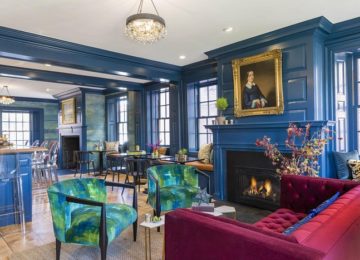For centuries, the Philippines has had a chunk of cultural resets from being colonized by different superpowers. The Philippines has become a melting pot of varied cultural influences, thus creating a unique Filipino identity.
And we aren’t just talking about food, language, and lifestyle. Even different real estate properties rose from the concepts of Filipino architects and builders who integrated foreign and local elements. Such unique structures helped shape the Philippines as a tourist and economic hotspot.
Here are nine state-of-the-art structures in the Philippines you should see.
Arch of the Centuries, the University of Santo Tomas
Heralded as the oldest Catholic university in Asia, the University of Santo Tomas withstood over four hundred years of Philippine history and calamities. After periods of wars and disasters, the university has undergone numerous repairs and reconstructions, with many original Baroque parts blended with the contemporary.
One remaining article of UST’s baroque past is its Arch of the Centuries, perhaps the last standing proof of the university’s four hundred years of grace and education. It was destroyed in World War II, then reconstructed in 1954. Then, the arch was declared a National Cultural Treasure by the National Museum in 2010.
The Arch of the Centuries is most well-known for its age-old superstition. Students should never exit the arch until they graduate. Otherwise, they will finish their course late, or an event will halt their university graduation.
Manila City Hall
Let’s go to the bustling Ermita District and marvel at the colossal Manila City Hall. It has served as the seat of the Mayor of Manila since 1901. Initially, the city hall was primarily made of Oregon pine until it was demolished thirty years later due to the structure’s weakened state. It was then rebuilt in the 1930s and reopened in 1941. By World War II, the city hall was heavily damaged, reconstructed, and further expanded in 1945.
From a human’s point of view, the 100-foot golden Clock Tower would be the first thing you’ll see. But from above, the city hall takes the shape of what many believe to be a coffin. The supposed coffin shape of the city hall adds to the tales of restless souls that wander the structure at night. Others think that the shape is a knightly shield, a metaphor for how the mayor valiantly protects and serves Manila.
The Rise, Makati City
Makati City is notable for its shopping centers, multiple dining places, and posh neighborhoods. Tucked away in the financial capital’s residential spots are unique modern structures that foster comfort and modernity. One example is The Rise, a condominium development in San Antonio Village, Makati.
The Rise may seem like your typical, exquisite high-rise development that caters to the sophisticated yuppie and businesspeople, but the condominium’s aesthetic is a strategic design to utilize renewable sources of energy. When you look at the building from above, you’ll see that it has a propeller-like structure. This design enables natural light and air to circulate throughout the building, keeping the units bright and tenants feeling cool. Not only is The Rise modern, but it advocates for sustainable living.
Calle Crisologo, Vigan
Along with Manila, Vigan in Ilocos Sur is one of the Philippine destinations known for its intact and well-preserved Spanish-style structures and towns. Tourists often flock to the city to stroll down the romantic Calle Crisologo. After taking a ride on the kalesa, take a tour in the Crisologo Museum and take a gander at the Crisologo Family’s memorabilia.
Calle Crisologo looks more stunning at night. You can experience a bit of time traveling and experience the quiet and romantic atmosphere of the lamp-lit cobblestone pavement akin to those in Paris and Madrid.
The Mind Museum, Taguig
Most museums take on traditional architectural designs to mirror the history of the artifacts they house and protect. But the Mind Museum in Bonifacio Global City, Taguig takes on a futuristic design, just like the scientific exhibits it hosts.
The architecture of the Mind Museum is the product of the geniuses of father-and-son tandem, Ed and Lor Calma. The museum’s design was inspired by cellular growth, a theme that suits its status as a science and interactive museum. Its design also facilitates natural ventilation and light to power the building. Talk about creativity and sustainability in one fun destination.
Visit the Mind Museum and explore the various galleries of atoms, fossils, galaxies, anatomy, and organisms. Your inner child will surely rejoice at these educational displays.
The Ruins, Talisay City
Yet another iconic residential building, The Ruins in Talisay City was the residence of sugar baron Don Mariano Ledesma Lacson and his eleven children. The estate covers 440 hectares and dons a classic Italian architecture. Imagine the opulent lifestyle of its former residents.
The Ruins’ nickname is “the Taj Mahal of the Philippines” due to its construction’s romantic tale. In the 1900s, Don Mariano Ledesma Lacson built the mansion to commemorate his wife, Maria Braga Lacson. She died giving birth to their eleventh child. However, The Ruins became its namesake after the house was burnt to the ground during World War II to disable Japanese troops into using it as a base. The mansion burned for three straight days.
San Pedro Cathedral, Davao City
Most centuries-old churches in the Philippines are of Baroque or classical architecture. But the Saint Peter Metropolitan Cathedral, or San Pedro Cathedral, in Davao City will have you confused with its frontal-curved solid structure. At first glance, the facade looks like a soaring bird or the bow of a ship. But, however you see it, this church is one iconic place in Davao City you should see for yourself.
San Pedro Cathedral’s famous curved structure comprises nipa and bamboo. At the same time, its body and other parts were built with a Spanish architectural style. This church embodies the mixed Hispanic and Filipino culture prevalent in the area during the colonial eras.
Cultural Center of the Philippines
The Cultural Center of the Philippines (CCP) is a complex spanning 88 hectares along the Manila Bay. In 1966, President Ferdinand Marcos and then-First Lady Imelda Marcos conceived a mixed-use complex that will house retail stores, museums, theatres, and various facilities. CCP then became the onset of Imelda’s “edifice complex.”
CCP is one of the massive structures you’ll see on your travel in Roxas Boulevard. The complex has held various musical performances, beauty pageants, and religious activities. The complex continues to expand to add more facilities that cater to all sorts of entertainment and recreation.
The Coconut Palace, CCP Complex
The Coconut Palace is, perhaps, the epitome of a traditional Filipino home. Made of Philippine coco lumber, coconut shells, and nipa, think of the Coconut Palace as an enlarged nipa hut or bahay kubo. Even the roof of the palace has the shape of the salakot, a Filipino traditional conical hat.
Like the CCP Complex, the Coconut Palace was built to display the Philippines’ luxury and supposed glory during the Marcos era. Initially, the palace was to be the guest house of Pope John Paul II during his visit. However, he refused to stay there as it was too extravagant, given the Philippines’ poverty level.
These nine structures are just some of the extraordinary edifices in the Philippines. Add these to your travel bucket list and seek the Philippines’ rich architectural history and real estate developments on your next trip.











